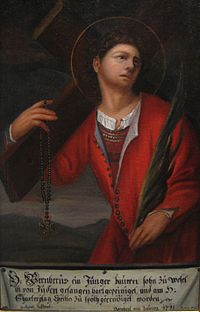This article includes a list ofgeneral references,butit lacks sufficient correspondinginline citations.(August 2012) |
Werner of Oberwesel(also known asWerner of BacharachorWerner of Womrath;1271 – 1287) was a 16-year-old boy whose unexplained death was blamed onJews,leading to revenge killings of Jews across Europe. He was venerated as a Christiansaint,and his memorial day was 19 April.
Saint Werner of Oberwesel (cult suppressed) | |
|---|---|
 Painting of Werner in the Jewish Museum, Berlin. | |
| Born | 1271 Womrath,Hunsrück |
| Died | 1287 Womrath, Hunsrück |
| Venerated in | Roman Catholic Church(Diocese of Trier) |
| Canonized | 1426-1429 |
| Feast | April 19 |
| Attributes | sickle, shovel, pan |
| Patronage | Winemakers |
| Controversy | Blood libel |
Catholic cultsuppressed | 1963 |
Saint Werner's Chapel inOberweselon theRhinewas established in 1289 and became a popular pilgrimage site. His veneration prompted other allegations against Jews, such asHost desecrationandritual murder.
Background
editBorn in 1271 inWomrath,Hunsrück,Werner came from a poor background. OnMaundy Thursday1287, his body was found nearBacharach.Certain Christians blamed his murder on the Jews, claiming that they had used his blood for the Jewish ritual of Passover (theblood libelagainst Jews). Similar anti-Jewish legends were widely circulated in theMiddle Ages.
The alleged murder was followed by a wave of pogroms against the Jewish community. Violence spread from theMiddle Rhineto theMoselleand theLower Rhineregion. The Jewish community turned to KingRudolf I,who was convinced the accusations were groundless. He fined the murderers of Jews and ordered the burning of the corpse of Werner to prevent any further veneration.
Veneration
editThe royal instructions to burn Werner's body, to prevent any further veneration, were not followed. Werner was buried on 30 April 1287 and allegedmiraclesbegan to be reported as the veneration spread as amartyrcult.The Cunibert Chapel in Bacharach was expanded beginning in 1289 to become the present Saint Werner's Chapel. The planned expansion of the chapel into a large church remained unfinished after 1338. A further construction[when?]also failed owing to the decline of the veneration of martyrs[citation needed]and shrinking revenue to the church from pilgrims.
The 1338 Latin legend alleges the Jews hung Werner by his feet. Then they had him thrown into the Rhine. At the point in Bacharach where the body was supposedly washed ashore, Saint Werner's Chapel was built. A second sanctuary was built in the Chapel of the Holy Spirit Hospital of Oberwesel, 7 kilometers downstream.
Count Palatine Ludwig IIIaspired to a revival of the cult. Attempts towardsCanonisationwere made 1426-1429, the chapel was finally completed.[when?]After 1548 some of the relics were transferred toBesançon,spreading the Werner mythology.
Although the chapel was destroyed in the 17th century, Werner was venerated in the Diocese of Trier until 1963.
In iconography, Werner is depicted with a sickle as well as a shovel and pan. He has been acknowledged as a patron saint of winemakers.
Contemporary attitudes
editIn 1963, Werner was removed from the calendar of theDiocese of Trier,but "Saint Werner of Oberwesel" still appears in German directories of saints.[citation needed]The chapel dedicated to him alongside the town wall facing the Rhine, which had been in ruins, was later renovated, and a plaque added, with a quotation fromPope John XXIII,recognizing the brotherhood of Christians and Jews, and asking for forgiveness for "the curse that we unrightfully affixed to the Jews’ name."
See also
editReferences
edit- Paul Gerhard Aring (1998). "Werner von Oberwesel". In Bautz, Traugott (ed.).Biographisch-Bibliographisches Kirchenlexikon (BBKL)(in German). Vol. 13. Herzberg: Bautz. cols. 837–838.ISBN3-88309-072-7.
- Jeffrey L. Sammons:Heinrich Heine: A Modern Biography:: (Princeton University Press, 1979), pages 89 to 96 —Heinrich Heine:Der Rabbi von Bacherach[sic](= "The Rabbi of Bacharach", unfinished historical novel, 1840).
- Rheinfriede Gleisner:Nach Juden-Pogromen kam Heiligen-Legende;in: Hunsrücker Zeitung, 18. April 1987, S. 27.
- Gottfried Kentenich (1910), "Werner. Diöcesanheiliger des Bisthums Trier",Allgemeine Deutsche Biographie(in German), vol. 55, Leipzig: Duncker & Humblot, pp. 45–46
- Gerd Hergen Lübben:Der Textfund zu Bacherach;in: Die Brücke – Forum für antirassistische Politik und Kultur, Heft 140, 2/2006 (Saarbrücken), S. 126–128; and in: Gerd Hergen Lübben,VERSIONEN III(»Fund zu Bacherach«), E-Book 2014,ISBN9783955778354.
- Gerd Mentgen:Die Ritualmordaffäre um den „Guten Werner “von Oberwesel und ihre Folgen;in: Jahrbuch für Westdeutsche Landesgeschichte 21 (1995), S. 159–198.
- Werner Wendling:Der „gute Werner “hat ausgedient;in: Rhein-Hunsrück-Zeitung, 4. Juli 2006, S. 17.
- Thomas Wetzstein:Vom „Volksheiligen “zum „Fürstenheiligen “. Die Wiederbelebung des Wernerkults im 15. Jahrhundert;in: Archiv für mittelrheinische Kirchengeschichte 51 (1999), S. 11–68.
- Daniela Wolf:Ritualmordaffäre und Kultgenese. Der „gute Werner von Oberwesel “;Bacharach: Bauverein Wernerkapelle Bacharach, 2002;ISBN3-00-009539-X.
- Eintrag im Ökumenischen Heiligenlexikon
Further reading
edit- Henri de Grèzes,Saint Vernier (Verny, Werner, Garnier), martyr, patron des vignerons en Auvergne, en Bourgogne et en Franche-Comté, sa vie, son martyre et son culte(1889)